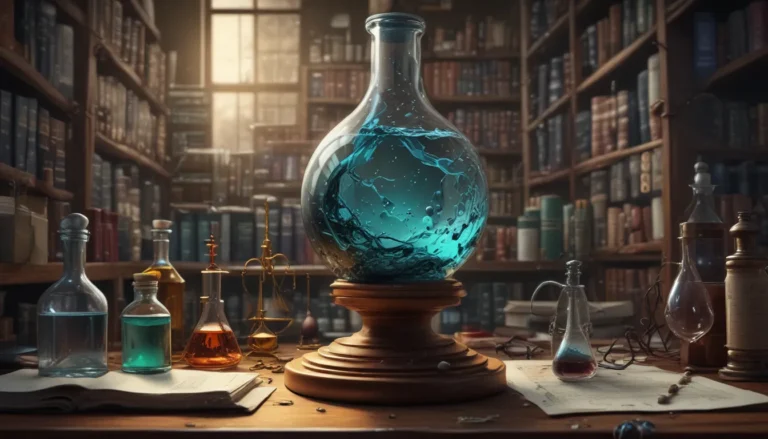A Note About Images: The images used in our articles are for illustration purposes only and may not exactly match the content. They are meant to engage readers, but the text should be relied upon for accurate information.
In the vast realm of chemistry, certain laws stand as pillars, illuminating the behavior of gases. Among these fundamental principles is Gay-Lussac’s Law, shedding light on the intricate relationship between the pressure and temperature of gases. Named after the renowned French chemist Joseph Louis Gay-Lussac, this law offers invaluable insights into gas behavior at varying temperatures.
Unraveling the Mysteries of Gay-Lussac’s Law
Dive into the depths of Gay-Lussac’s Law and uncover a treasure trove of 15 captivating facts that will spark your curiosity. From its origins to its impact on diverse industries, this exploration promises an enlightening journey filled with intriguing discoveries. Get ready to be amazed as we unravel the fascinating nuances of this essential law.
Key Discoveries and Takeaways
- Understanding Gas Behavior: Gay-Lussac’s Law elucidates how the pressure of a gas changes with temperature, offering insights into everyday phenomena like weather systems and hot air balloons.
- Predictive Power: By adhering to Gay-Lussac’s Law, scientists can anticipate how gases will respond to temperature fluctuations, making it a pivotal concept in the realm of chemistry with far-reaching practical applications.
Delving Deeper into Gay-Lussac’s Law
The Force Behind Temperature and Pressure
Gay-Lussac’s Law, also referred to as the pressure-temperature law, establishes that the pressure of a gas is directly linked to its absolute temperature when the volume and quantity of gas remain constant. This foundational principle sheds light on gas behavior under diverse temperature conditions.
A Tribute to Scientific Pioneers
This law bears the name of Joseph Louis Gay-Lussac, the visionary French chemist who first articulated its principles. His groundbreaking work on gases and immense contributions to the field of chemistry have solidified his legacy.
Deciphering the Equation
Mathematically, Gay-Lussac’s Law is expressed as P1/T1 = P2/T2, with P1 and P2 denoting initial and final pressures, and T1 and T2 representing initial and final temperatures, respectively. This equation serves as a predictive tool for assessing pressure variations with temperature changes.
Practical Applications and Implications
Ideal Gases in Focus
Gay-Lussac’s Law pertains to ideal gases, theoretical entities devoid of intermolecular forces and occupying minimal volume. Real gases may exhibit slight deviations from ideal behavior under extreme conditions.
Insights into Gas Volume
When gas volume remains constant, Gay-Lussac’s Law dictates that temperature increases lead to pressure escalation, while temperature decreases result in pressure reduction. This law offers a window into the relationship between gas pressure and temperature shifts.
Closed Systems and Gas Behavior
The purview of Gay-Lussac’s Law extends to gases confined within closed systems, where volume remains steady. It unravels the dynamics of pressure fluctuations in response to temperature variations within such systems.
Interplay with Charles’s Law
Gay-Lussac’s Law shares ties with Charles’s Law, which elucidates the relationship between gas volume and temperature under constant pressure. Together, these laws form the bedrock of the ideal gas law.
Real-World Implications and Applications
Practical Significance
Gay-Lussac’s Law finds myriad applications across various industries. It facilitates comprehension of gas engine operations, gas behavior in weather systems, gas compression in scuba diving, and industrial processes involving gases.
Experimental Roots
Grounded in empirical investigation, Gay-Lussac’s Law emerged from meticulous experiments conducted by its namesake. Through a series of controlled studies on different gases, the direct correlation between pressure and temperature was unveiled.
Temperature Revelation
This law enables the determination of gas absolute temperatures by gauging pressure at distinct known temperatures. Such revelations are pivotal in shaping temperature scales like the absolute or Kelvin scale essential for scientific calculations.
Further Explorations and Enchantments
Stoichiometry Significance
In the realm of stoichiometry, Gay-Lussac’s Law plays a vital role in unveiling quantitative relationships between reactants and products in chemical reactions. It aids in volume computations based on temperature and pressure parameters.
Wide Temperature Range Relevance
Gay-Lussac’s Law stands valid across a spectrum of temperatures, encompassing both low and high extremes. Its applicability under varying conditions allows scientists to anticipate gas behavior under diverse scenarios.
Aerial Revelations
By delving into Gay-Lussac’s Law, one can gain profound insights into the functioning of gases within hot air balloons. The correlation between temperature, pressure, and ascent showcases the law’s practical impact in aviation.
Concluding Thoughts
In the expansive universe of chemistry, Gay-Lussac’s Law reigns supreme as a foundational principle governing gas behavior. From its inception to its real-world applications, this law serves as a beacon guiding scientific exploration and industrial advancements. Embrace the marvels of Gay-Lussac’s Law, and witness the intricate dance of gases in response to temperature variations, illuminating the wonders of the physical world.
FAQs: Satisfy Your Curiosity
- Discoverer: French chemist Joseph Louis Gay-Lussac pioneered the unveiling of Gay-Lussac’s Law in the early 19th century.
- Core Tenet: Gay-Lussac’s Law asserts that gas pressure is directly proportional to temperature under constant volume and gas quantity.
- Applications: This law finds practical utility in industrial processes, weather system analysis, pressure vessel design, and scientific research.
- Applicability: Gay-Lussac’s Law applies to ideal gases, while real gases may exhibit deviations from ideal behavior under extreme conditions.
- Interrelationship: Gay-Lussac’s Law stands alongside Boyle’s Law and Charles’s Law as fundamental gas laws, forming the backbone of the ideal gas law equation.
Embrace the Enigma of Gay-Lussac’s Law
Embark on a journey of scientific discovery and unravel the mysteries of Gay-Lussac’s Law. Explore the intricate interplay of pressure and temperature in gas behavior at constant volumes, and immerse yourself in 15 enigmatic facts that illuminate the captivating world of chemistry. Expand your horizons, deepen your understanding, and marvel at the foundational principles underpinning the complex tapestry of scientific exploration. Welcome to the realm of Gay-Lussac’s Law, where wonder and knowledge intertwine to spark inspiration and awe.






